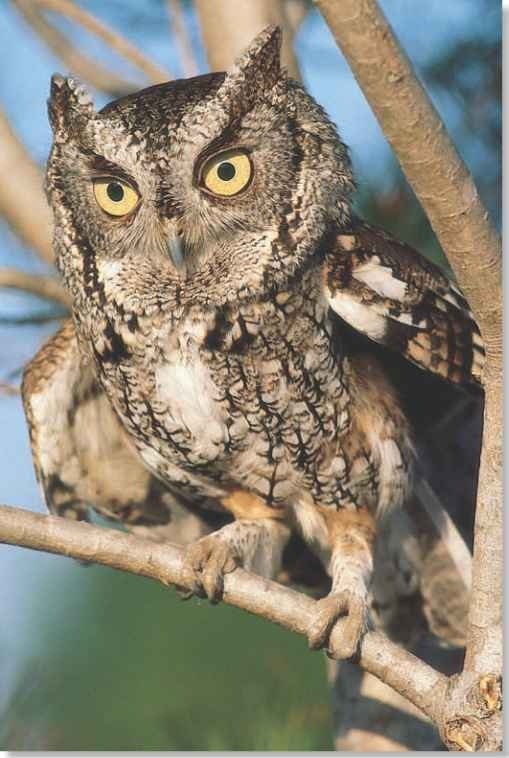ORDER
Strigiform.es
FAMILY
Strigidae
GENUS & SPECIES
KEY FEATURES
• Cries out a shrill, chilling “screech” during the night, hence its common name
• Species has three colors —gray, red and brown — none of which has to do with age, sex or season
• Incredible ability to camouflage itself; can blend with tree bark or look like a tree branch
• Most nocturnal owl
in North America
WHERE IN THE WORLD ?
Widely distributed throughout North America; from southern Canada, to the south, east and central U. S. (east of the Rocky Mountains) and northeast Mexico
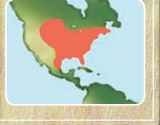
Lifecycle
Despite its small size, the eastern screech owl is a fearless predator capable of snatching insects in flight and killing mammals and birds larger than itself.
HABITAT
The eastern screech owl is found in a wide variety of habitats, including deciduous forests, open woodlands, orchards, cultivated land, parks and gardens. It can also be found in oak forests located at the edge of Mexican deserts and up to 6,000′ in the Rockies. Due to its small size, it is capable of swift flight among the dense trees of the forests.
Mixed colors
Mixed pairs and offspring share the same area.

# In the backwoods of North America, the screech owl is regarded as a bad omen, its mournful wail foretelling disaster.
Red screech owls have higher metabolic rates than gray ones, which makes them more likely to die during heavy snowfalls.
BREEDING
Like most owls, the eastern screech owl mates for life. After spending the winter alone, the male calls each night from February onward to attract his mate. Once paired, the owls usually nest in the male’s roosting site, often an abandoned woodpecker hole or a man-made nest box. Together the pair fiercely defends their nest, even attacking humans who venture too close. No nesting materials are gathered; the eggs are simply laid on the bottom of the cavity, where the female alone incubates them for 21 -30 days. The male provides her with food during this period and feeds the helpless chicks once they hatch. After 26-28 days, the chicks take their first flight.Young screech owls usually remain with their parents until they mate themselves.
FOOD & HUNTING
The eastern screech owl is active only at night. It is most easily recognized by its cry, which consists of a mournful whistle ending in a shrill shriek Used by the male as his territorial warning, the cry is heard soon after dusk, when the owl emerges from its roosting site to hunt. Hunting in the air and on the ground until dawn, the screech owl feeds mainly on insects, shrews and mice, but it can take a wide variety of prey, such as birds, fish, amphibians, spiders and earthworms. Small mammals make up most of the owl’s diet in the winter months; in the summer, it eats mainly insects.
In order to survive the severe winter months, the owl puts on weight during the fall and stores food in caches. It remains inactive in the harshest weather, feeding on the stored prey. On winter nights when the weather is suitable, the owl ventures out and hunts for small birds and rodents.
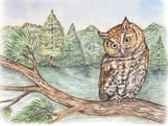
1 Perch…
Perched high on the branch of a tree, the owl scans the ground and listens for any type of movement from potential prey.
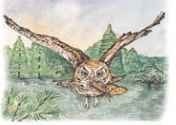
2 Chase…
Flying swiftly, the owl darts after nocturnal insects, catching them in midair. With a loud click of its bill, the owl snaps up a moth.
Huddle up Owl chicks hatch separately and vary in size and age.
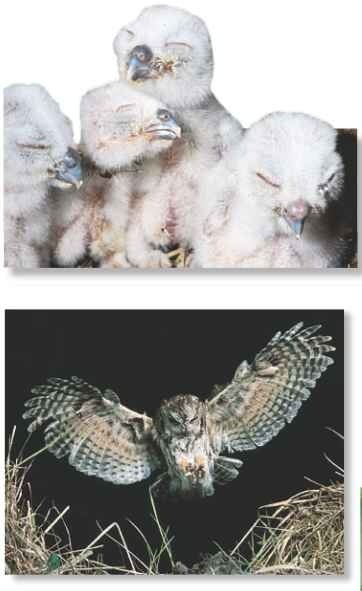
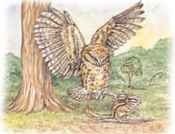
3 Snatch…
Spotting a chipmunk from the air, the owl silently descends. With wings and tail splayed, it snatches the chipmunk in its sharp talons.
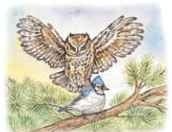
4 Swoop
In a surprise attack, the owl swoops down on a blue jay. No match for the talons, the jay falls victim to the voracious hunter.
CONSERVATION
In 1981, the eastern screech owl was listed on the National Audubon Society’s Blue List of declining species and listed as a Species of Special Concern in 1982 and 1986. It is common throughout its range, and is now protected by law. Threats come mainly from habitat destruction.The owl frequently collides at night with car traffic and even trains. It also has suffered from thinning eggshells caused by pesticide pollution.
BEHAVIOR
The eastern screech owl sleeps by day in a variety of places, including hollow and leafy trees, rock crevices, nest boxes and under the eaves of barns. It can camouflage itself very effectively during the daytime. With eyes closed and ear tufts raised, the gray owl closely resembles a broken branch, and the red and brown phases tend to blend with the bark of certain pine trees. Confident in its ability to camouflage, the eastern screech owl remains completely still even when closely approached. Humans have lifted it off its perch; the owl still acts as if it is camouflaged.
A frog’s fate
Ail eastern screech owl snatches an unsuspecting frog with its sharp talons and prepares to take the first bite.
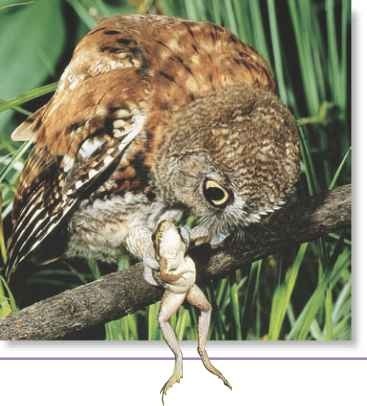
Profile
Eastern Screech Owl
All three colors of the owl can be found in its North American range; all have keen night vision and sharp talons that make them fierce predators.
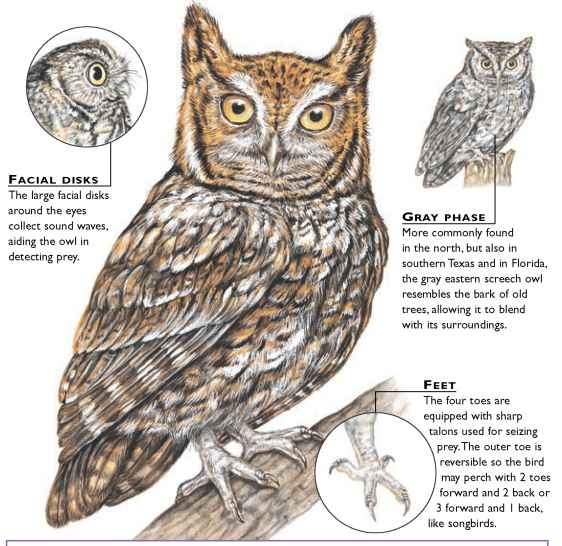
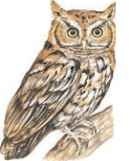
Eastern screech owl
CREATURE COMPARISONS-
The whiskered screech owl (Otus trichopsis) closely resembles the eastern screech owl but only has two color variants — gray and red. It prefers higher elevations than the screech owl and seeks out extremely dense forests of oak, oak-pine and sycamore. At a length of 6.5-8″ and a weight of 3-3.5 oz., the whiskered screech owl is smaller and feeds on insects in flight, rather than capturing small mammals and birds like its eastern cousin.
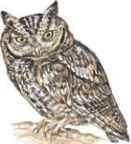
Whiskered screech owl
| VITAL | |
| STATISTICS | |
| Weight | 3-8 oz. |
| Length | 7-10″ |
| Wingspan | 18-24″ |
| Sexual | Maturity | 1 year |
| Breeding – 1 Season | February-July |
| Number [ of Eggs | Up to 8, but Usually 4-5 |
| Incubation Period | 21-30 days |
| Fledging i Period | 26-28 days |
| Breeding f Interval | -1 year |
| Typical 1 Diet | Mainly insects but also small mammals, frogs, lizards and birds |
| Lifespan | Up to 13 years |
RELATED SPECIES
The genus Otus con-I tains about 56 species, ‘ including the eastern .screech owl’s relative, the western screech, O. kennicotti. Other well-known species are the common scops owls, O. scops and O. sunia, 1 of Europe and Asia. The order Strigiformes contains 10 species of barn i owls (family Tytonidae) and about 175 species of true owls (family j Strigidae).
